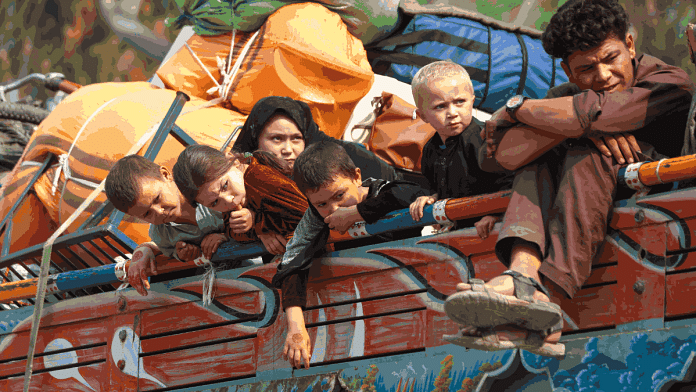New Delhi: After the Pakistan government launched a nationwide deportation operation against roughly 1.7 million (17 lakh) undocumented Afghan refugees, a large number of them have begun fleeing the country over the past week. Around 6 lakh of these refugees arrived in Pakistan after the Taliban returned to power in August 2021.
With the 1 November deadline having lapsed, thousands of refugees facing arrest and expulsion have been forced to return to Taliban-ruled Afghanistan. This mass migration comes weeks after the country faced a series of deadly earthquakes in Herat which killed 1,400 people and left 1,800 injured.
This return of migrants is bound to impact the country already suffering from numerous international sanctions and economic decline. Afghanistan’s economy has shrunk 25 percent since the Taliban takeover and also has a substantial trade deficit, according to an October World Bank report. The unemployment rate has also more than doubled since the takeover.
The interim Taliban regime has stated that it will register the migrants, keep them in refugee camps and try to find them jobs.
While many international human rights groups, such as the Office of the United Nations High Commissioner for Human Rights (OHCHR), and Amnesty International have criticised and raised an alarm over the forced deportation order, Islamabad maintains that due to a rise in terrorist attacks and suicide bombings, it must prioritise its own economic affairs and security.
Also read: Canada’s probe into Nijjar killing ‘tainted’, ‘show evidence’, says Indian envoy in Ottawa
Why is Pakistan deporting refugees
Pakistani authorities said Afghan nationals were found to be involved in attacks against the government and the army, including 14 of this year’s 24 suicide bombings.
Pakistan has been facing numerous economic challenges and rising unemployment over the past year. In February, inflation in the country surged to 31.5 percent, the highest in five decades, as quoted in media reports citing the latest figures released by the Pakistan Bureau of Statistics on 1 March. This, along with devastating floods last year, led to a severe food crisis across the country. The government, which received a $3 billion IMF bailout, believes undocumented migrants have drained its resources for decades.
Therefore, earlier this month, Caretaker Interior Minister Sarfraz Bugti announced the Pakistan government’s plan to deport all illegal immigrants. According to the UN, 59,780 Afghans had left Pakistan two weeks since the announcement and more than 200,000 have left Pakistan in the past week. According to Taliban refugee ministry spokesman Abdul Mutaleb Haqqani, the recent daily returnee figures are three times the normal.
How Afghan refugees ended up in Pakistan
While a large number of Afghans fled to Pakistan in 2021 after Taliban’s return to power, many had been seeking refuge in the country since the late 1900s following the Soviet Union’s invasion of Afghanistan in 1979.
While by 1979-end, more than 4,00,000 refugees had migrated to Pakistan, within the next decade, four to five million more sought refuge there by 1988. During this period, Pakistan welcomed these refugees as means of exerting political influence in Afghanistan as well as reducing tensions between the two countries over the Durand Line.
The Durand Line is the 2,640-km line between Afghanistan and Pakistan, established in 1893 under British colonial rule. This line has been a point of contention between the two countries for decades, as it crosses through numerous Pashtun tribal areas. Pashtuns are a nomadic ethnic group originating in the Afghanistan–Pakistan region. They are one of the largest ethnic groups in Afghanistan and the second-largest ethnic group in Pakistan.
As millions of refugees began migrating to Pakistan, it received large levels of international financial support and built various refugee camps across the country. With tensions and crises within Afghanistan continuing over the years, from the Soviet invasion to a civil war and rise of Taliban, refugees continued to migrate to their neighbouring countries, primarily Pakistan.
Reportedly between 1979 to 2001, a third of Afghanistan’s population migrated to Pakistan. However, after the downfall of the Taliban in 2001, roughly 1.5 million refugees returned to Afghanistan in 2002, and thousands continued to return over the years. During this movement, many Taliban militants also migrated to Pakistan and searched for safe haven among the Afghan refugee population. Eventually, these camps became crucial for the group’s recruitment activities.
Not all Afghan refugees migrated back to the country during these two decades. In 2020, media reports highlighted that many second, third, and fourth generation Afghan refugees were living in Pakistan. However, many do not have legal refugee status even today and remain undocumented.
Until 2006, these immigrants did not need documentation to live in Pakistan. In 2007, the government, along with the UN High Commissioner for Refugees, began issuing Proof of Registration (PoR) cards. For roughly 1.4 million (or 14 lakh) refugees, their PoR cards expired on 30 June this year, leaving them vulnerable to deportation.
(Edited by Smriti Sinha)
Also read: Defence cooperation, Canada row, human rights, China — what’s on US’s agenda for dialogue with India



